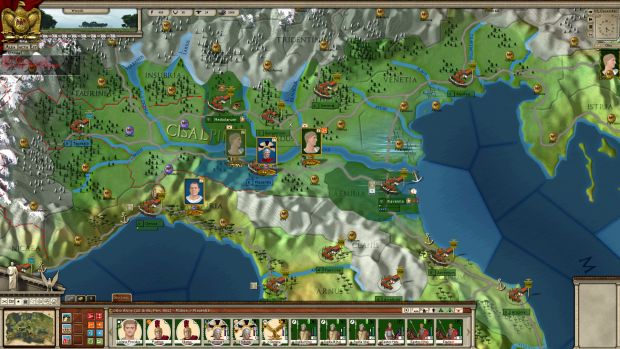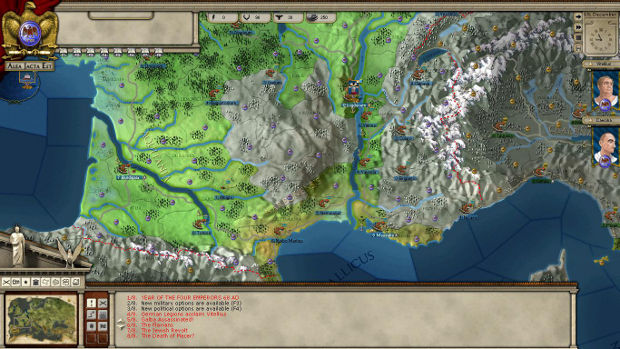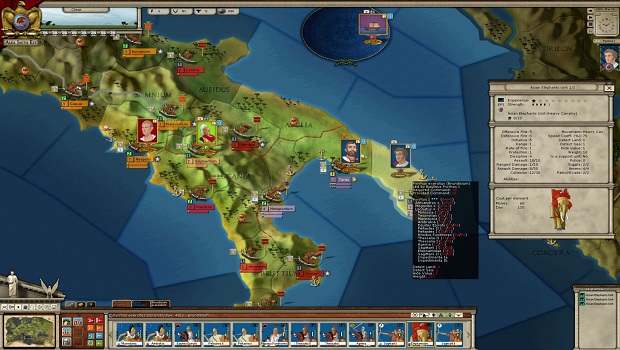The recent couple of years have seen a glut of Roman themed strategy games. Total War: Rome 2, Hegemony Rome: The Rise of Caesar and others have given us our fill of the Roman Eagle. Yet, those efforts lack serious strategic depth and historical accuracy. Thankfully, AGEod, a small development studio out of France, stepped out Alea Jacta Est, filling the void with a complex but rewarding game that, if you’re up to the challenge, will provide you with many hours of great Roman strategic fun.
Alea Jacta Est is a quality member AGEod’s series of simultaneous turn-based games. Other games have touched on the American Civil War, the American Revolution, Frederick the Great, the campaigns of Napoleon, World War I, and the Victorian age. Alea Jacta Est is, then, a bit of a departure in time period, as it moves the system to the eras of both the Roman Empire and Republic, focuses on those times when Rome found itself engaged in civil war. The game’s scenarios depict a wide variety of different conflicts, from the Sertorian revolt to the Year of the Four Emperors. The game’s signature conflict is the conflict between Pompey the Great and Julius Caesar (from which it draws its titular quote), but all of the scenarios are well-constructed, well-researched, and reflective of the historical conditions and constraints. Additionally, if you are so inclined, the game has two stand alone expansion: Birth of Rome (focusing on the wars of the Roman Republic) and Parthian Wars (depicting, well, the Parthian Wars).
The game map consists of areas marking out the ancient Mediterranean, and extends as far north as Britain. It’s not the prettiest map in the business, but it won’t make your eyes bleed, and all the important terrain elements are easy to spot. The game itself has a very board game-like look to it- armies are represented by standup leader portraits. I’m not a big fan of the interface- it displays your army in a general sense, and selecting an army shows all the units. Unfortunately, these units display surprisingly little information, forcing you to click further into the interface for each unit to learn more. It also doesn’t help that the game tutorial doesn’t indicate what any of the values mean. Caesar, for example, is a 6-7-7, but I had to go to the manual to discover what that actually meant. The tutorial does a decent job of explaining game mechanics, but doesn’t really explain what’s going on in any depth. I ended it knowing how to move units around, but also knowing that if I wanted a chance at winning at anything, I had better start memorizing the manual.
That said, I’m glad I put the time in to actually learn what was going on. Alea Jacta Est is an excellent simulation, with a turn structure that’s both true to the operational scale the game is attempting to portray, and compelling (and nail-biting) for the player. Players spend their time plotting their maneuvers for the coming months. Armies plot their moves from area to area, with each action taking a certain number of days. Each force can be give one of four postures, each a varying degree of aggressiveness. Forces with high aggressiveness will seek to engage their foes, while forces in defensive or passive postures will avoid contact (or fall back when attacked). After all your moves for the upcoming map are plotting, you submit your turn. Your opponent plots their moves as well, and then two sets of moves are resolved simultaneously.
You’ll see your forces and those of your opponent move around the screen, day by day. If any combats occur, you’ll see the battle results display. Battles are a complex mix of terrain (which affects both opening range and maximum unit frontage), force mix and morale, leadership, numbers and force posture. They can last up to six rounds per day (and then proceed on to several days). Two well led, well composed forces can slug it out for some time. The game really rewards well planned maneuvers- an assault over a river into the mountains in a poorly supplied area is probably going to be annihilated, but the same assault using a different approach and better logistical support will experience success.
At the end of the day, Alea Jacta Est is a game about mastering the important logistical and operational aspects of ancient warfare. It is very complex and intimidating to the beginner. But for those willing to put in the effort, they’ll experience an authentic recreation of operations in the Roman era. It may also require a bit of study (a lot of the unit types are listed in Latin, which if you studied Roman military history like I did you’ll find awesome, but if you didn’t, you may have difficulty telling your equites (cavalry) from your epibatai (marine infantry)). For the hardcore military fanatic or the Roman history buff, Alea Jacta Est is one of the most compelling, engaging and fulfilling titles on the market. Others, however, will be turned off by the visuals, by the occasional text error, but mostly by the daunting complexity.
I, for one, really enjoyed my experience, and was happy to see the game expanded to include the Punic Wars and other Roman conflicts. Delenda Est Carthago!
This review was originally published at Vagary.tv, reviewed using code provided by the developer.



